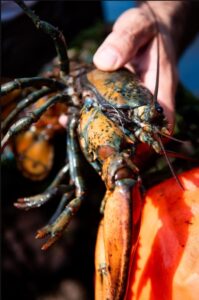Cape Cod and lobster are as much a match as peanut butter and jelly. It’s hard to imagine a summer without lobster rolls or that quintessential Cape Cod food adventure, a clambake, with lobsters steamed under layers of seaweed.
Catches in Cape Cod Bay were good for many years, and prices were good, too. But lobstermen here started worrying in the late 1990s when the fishery collapsed in Long Island Sound. And that worry hasn’t gone away, because environmental changes here resemble those that were affecting Long Island Sound back then.
In the aftermath of Tropical Storm Floyd in August 1999, the lobsters in Long Island Sound started coming up dead or lethargic, not making it back to the docks alive. Fall landings for all Connecticut ports dropped between 91 and 99 percent that year, according to a joint report of the state’s dept. of environmental protection and marine fisheries office published in 2000.

Fast forward 25 years: hopes for a Long Island Sound population rebound have not panned out. A December 2021 report in the Portland Press Herald introduced Michael Grimshaw this way: “Grimshaw is believed to be the last full-time commercial lobsterman in Connecticut.” His traps used to bring in up to a few thousand pounds a day, wrote reporter David Abel. A good day was now getting him 50 pounds, Grimshaw told him.
In other words, the fishery was in complete collapse.
Of course, a mountain of science has been done to investigate what might have made the Long Island Sound die-off so fast and so complete. Right away, people speculated that a temperature surge brought on by the storm might have been the problem. Scientists at the University of Connecticut identified a paramoeba infestation as the immediate cause of lobster mortality in samples they took. Fishermen also pointed to the fact that mosquito pesticides had been used heavily in New York because West Nile Virus had appeared shortly before the storm. Studies have not borne that theory out, although many still believe that pesticide runoff must have played a role in how quickly the lobsters went down.
The state’s supervising fisheries biologist, Colleen Bouffard, told ABC’s New Haven affiliate last week that there wasn’t one factor completely responsible for the die-off. But there is one thing everyone agrees on: lobsters are adapted for life in cold water, and the water temperatures in Long Island Sound have warmed to the point where lobsters can’t thrive there.
The next inshore lobster fishery going north and east from Long Island Sound is ours in Cape Cod Bay. The news from here isn’t good, either. Catches are down due to warming waters that are driving lobsters farther north. Nitrate runoff from the shore and algae blooms are also stressors. Many lobstermen here have moved their traps north to Stellwagen Bank or east on the backshore by Peaked Hill Bar.
Hypoxia is showing up here: low levels of dissolved oxygen creating dead zones, also referred to as “the blob.” Hypoxia has been the cause of two lobster die-offs here in 2019 and 2020.
This is a product of warming ocean water related to climate change. Researchers at Woods Hole explain it this way: As the surface waters have warmed, strong winds from the southwest have decreased, and winds from the northeast have increased substantially. This is making the bay more stratified, with surface water less likely to mix with colder, denser deep water. That sets up the conditions for algae blooms, and when the algae dies and microbes decompose it, that uses up the oxygen in the water.
But on the water, not everything fits the same pattern. Lobsterman Dana Pazolt told me that the low oxygen problem didn’t happen this year. Or at least the lobsters seem to have been able simply to avoid hypoxic areas. Pazolt watches the thermocline — the transition between warm and cold water — and said that this year the water stayed cooler, even at relatively shallow depths. “Warm water existed only down to 35 feet for most of the year this year,” Pazolt said.
I don’t know whether the Cape Cod Bay lobster fishery is following the same disastrous path as the Long Island Sound fishery, but it’s hard to be optimistic.



